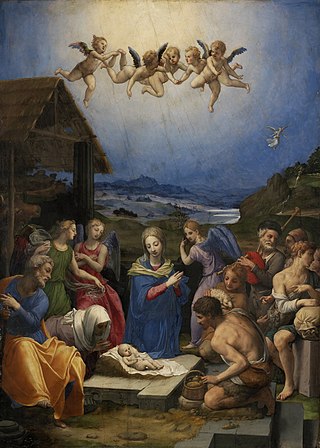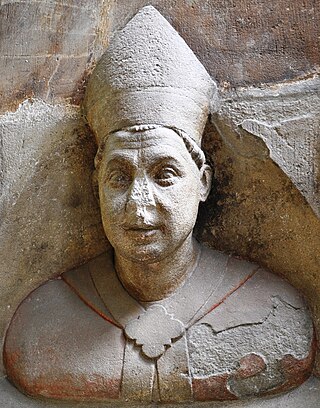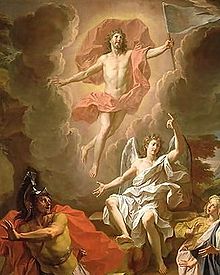
The Paschal greeting, also known as the Easter Acclamation or Easter Day Greeting, is an Easter custom among many Christian churches, including Eastern Orthodox, Oriental Orthodox, Roman Catholic, Anglican, Lutheran, Methodist, Presbyterian, and Congregational.

"Hark! The Herald Angels Sing" is an English Christmas carol that first appeared in 1739 in the collection Hymns and Sacred Poems. The carol, based on Luke 2:14, tells of an angelic chorus singing praises to God. As it is known in the modern era, it features lyrical contributions from Charles Wesley and George Whitefield, two of the founding ministers of Methodism, with music adapted from "Vaterland, in deinen Gauen" of Felix Mendelssohn's cantata Festgesang.

"Christ the Lord Is Risen Today" is a Christian hymn associated with Easter. Most of the stanzas were written by Charles Wesley, and the hymn appeared under the title "Hymn for Easter Day" in Hymns and Sacred Poems by Charles and John Wesley in 1739. The hymn eventually became well known for the "Alleluia" sung as a melisma after each line, which was added by an unknown author, probably to fit the commonly used hymn tune, "Easter Hymn". It remains a traditional processional hymn on Easter Sunday.

"Regina caeli" is a musical antiphon addressed to the Blessed Virgin Mary that is used in the liturgy of the Roman Rite of the Catholic Church during the Easter season, from Easter Sunday until Pentecost. During this season, it is the Marian antiphon that ends Compline and it takes the place of the traditional thrice-daily Angelus prayer.

The Orgelbüchlein BWV 599−644 is a set of 46 chorale preludes for organ — one of them is given in two versions — by Johann Sebastian Bach. All but three were written between 1708 and 1717 when Bach served as organist to the ducal court in Weimar; the remainder and a short two-bar fragment came no earlier than 1726, after the composer’s appointment as cantor at the Thomasschule in Leipzig.
An Easter Drama is a liturgical drama or religious theatrical performance in the Roman Catholic tradition, largely limited to the Middle Ages. These performances evolved from celebrations of the liturgy to incorporate later dramatic and secular elements, and came to be performed in local languages. They were succeeded by the Passion Plays.
"For the Beauty of the Earth" is a Christian hymn by Folliott S. Pierpoint (1835-1917).
Christus is an oratorio by the Hungarian composer and pianist Franz Liszt. The oratorio takes the traditional plot of Jesus Christ's life from his birth to his passion and resurrection, using Bible texts, and is thus somewhat reminiscent of another famous religious work, Messiah by George Frideric Handel.

O filii et filiae is a Christian hymn celebrating Easter. It is attributed to Jean Tisserand, a Franciscan friar.

Thine Be the Glory, Risen Conquering Son, also titled Thine Is the Glory, is a Christian hymn for Easter, written by the Swiss Protestant minister, Edmond Budry (1854–1932), and set to the tune of the chorus "See, the Conqu'ring hero comes" from the third section of Handel's oratorio Judas Maccabaeus. The hymn is sometimes sung at weddings or funerals.

"Soldiers of Christ, Arise" is an 18th-century English hymn. The words were written by Charles Wesley (1707–1788), and the first line refers to the armour of God in Ephesians 6:10–18.
The Lyra Davidica is a collection of hymns and tunes first published in 1708. The volume was published by John Walsh (printer). The collection was one of many containing hymns translated (mostly) from German, at a time when Anglicanism was heavily influenced by German evangelical pietism.

"Gelobt sei Gott im höchsten Thron" is a hymn for Easter in 20 stanzas in German by Michael Weiße, widely known with a later melody by Melchior Vulpius. Shortened, it is part of current Protestant and Catholic German hymnals.

"Christ ist erstanden" is a German Easter hymn, and is possibly the oldest Christian liturgical German song. It has inspired the music of numerous composers, such as Ludwig Senfl and Heinrich Schütz, as well as modern composers such as Oskar Gottlieb Blarr and Enjott Schneider, and has appeared in 45 hymnals, including the current German Catholic and Protestant hymnals. Translations and paraphrases include a version by Catherine Winkworth which has appeared in 231 hymnals. "Christ ist erstanden" also inspired Martin Luther to write "Christ lag in Todes Banden", deriving the melody from it.
"Jesus Christus, unser Heiland, der von uns den Gotteszorn wandt" is a Lutheran hymn in ten stanzas by Martin Luther for communion, first published in 1524 in the Erfurt Enchiridion. It is one of Luther's hymns which he wrote to strengthen his concepts of reformation. The models for the text and the melody of Luther's hymn existed in early 15th-century Bohemia. The text of the earlier hymn, "Jesus Christus nostra salus", goes back to the late 14th century. That hymn was embedded in a Hussite tradition.

"Jesus Christus nostra salus" is a hymn in Ecclesiastical Latin celebrating the Eucharist. It first is confirmed to have appeared in a manuscript in 1410. For a long time it was attributed to Johannes Hus, but was more likely written by the Archbishop of Prague, Jan of Jenštejn. Several hymns in different languages were derived from it, among others Martin Luther's "Jesus Christus, unser Heiland, der von uns den Gotteszorn wandt".
"Christ the Lord Is Risen Again!" is a German Christian hymn published by Michael Weiße in 1531 based on an earlier German hymn of a very similar name. It was translated into English in 1858 by Catherine Winkworth.

"Christus, der uns selig macht" is a German Lutheran Passion hymn in eight stanzas in German by Michael Weiße, written in 1531 as a translation of the Latin hymn "Patris Sapientia" to an older melody of the Bohemian Brethren.
Christ ist erstanden is a German Easter hymn and is possibly the oldest Christian liturgical German song.

Drei Motetten, Op. 39, is a collection of three sacred motets for women's voices and organ by Felix Mendelssohn. Composed in 1830 for different liturgical occasions and in different scoring, they were published together in 1838.














